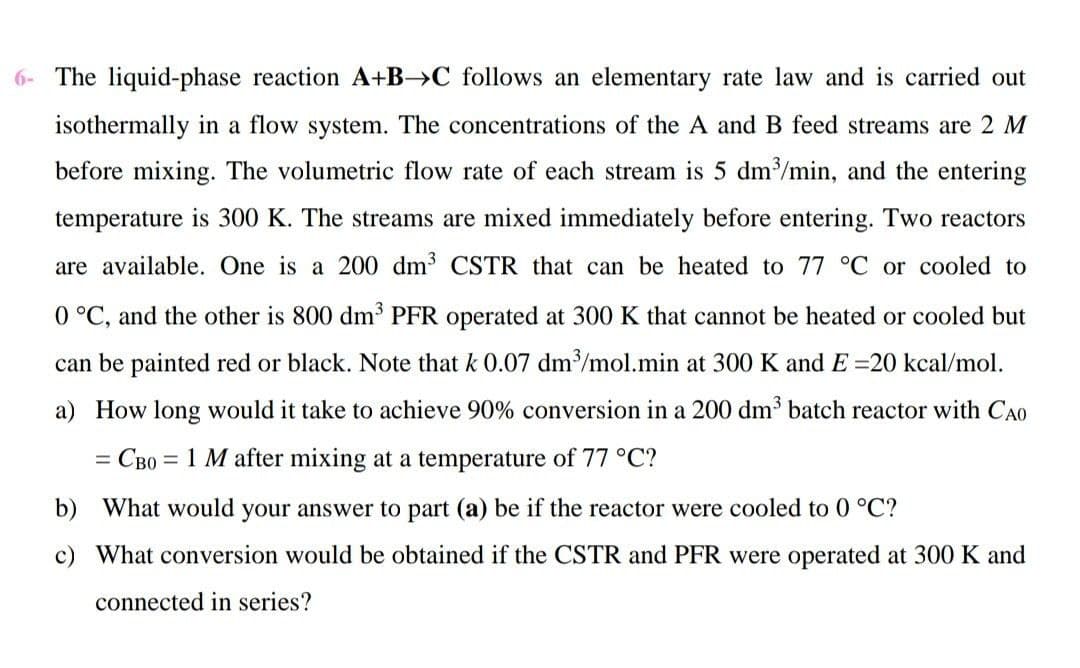The liquid-phase reaction A+B→C_follows an elementary rate law and is carried out isothermally in a flow system. The concentrations of the A and B feed streams are 2 M before mixing. The volumetric flow rate of each stream is 5 dm/min, and the entering temperature is 300 K. The streams are mixed immediately before entering. Two reactors are available. One is a 200 dm CSTR that can be heated to 77 °C or cooled to 0 °C, and the other is 800 dm³ PFR operated at 300 K that cannot be heated or cooled but can be painted red or black. Note that k 0.07 dm³/mol.min at 300 K and E =20 kcal/mol. a) How long would it take to achieve 90% conversion in a 200 dm3 batch reactor with CAO = CB0 = 1 M after mixing at a temperature of 77 °C? %3D What would your answer part (a) be if the reactor were cooled to 0 °C? c) What conversion would be obtained if the CSTR and PFR were operated at 300 K and connected in series?
The liquid-phase reaction A+B→C_follows an elementary rate law and is carried out isothermally in a flow system. The concentrations of the A and B feed streams are 2 M before mixing. The volumetric flow rate of each stream is 5 dm/min, and the entering temperature is 300 K. The streams are mixed immediately before entering. Two reactors are available. One is a 200 dm CSTR that can be heated to 77 °C or cooled to 0 °C, and the other is 800 dm³ PFR operated at 300 K that cannot be heated or cooled but can be painted red or black. Note that k 0.07 dm³/mol.min at 300 K and E =20 kcal/mol. a) How long would it take to achieve 90% conversion in a 200 dm3 batch reactor with CAO = CB0 = 1 M after mixing at a temperature of 77 °C? %3D What would your answer part (a) be if the reactor were cooled to 0 °C? c) What conversion would be obtained if the CSTR and PFR were operated at 300 K and connected in series?
Introduction to Chemical Engineering Thermodynamics
8th Edition
ISBN:9781259696527
Author:J.M. Smith Termodinamica en ingenieria quimica, Hendrick C Van Ness, Michael Abbott, Mark Swihart
Publisher:J.M. Smith Termodinamica en ingenieria quimica, Hendrick C Van Ness, Michael Abbott, Mark Swihart
Chapter1: Introduction
Section: Chapter Questions
Problem 1.1P
Related questions
Question

Transcribed Image Text:6- The liquid-phase reaction A+B→C follows an elementary rate law and is carried out
isothermally in a flow system. The concentrations of the A and B feed streams are 2 M
before mixing. The volumetric flow rate of each stream is 5 dm/min, and the entering
temperature is 300 K. The streams are mixed immediately before entering. Two reactors
are available. One is a 200 dm CSTR that can be heated to 77 °C or cooled to
0 °C, and the other is 800 dm³ PFR operated at 300 K that cannot be heated or cooled but
can be painted red or black. Note that k 0.07 dm/mol.min at 300 K and E =20 kcal/mol.
a) How long would it take to achieve 90% conversion in a 200 dm³ batch reactor with CA0
= CB0 = 1 M after mixing at a temperature of 77 °C?
b) What would your answer to part (a) be if the reactor were cooled to 0 °C?
c) What conversion would be obtained if the CSTR and PFR were operated at 300 K and
connected in series?
Expert Solution
Trending now
This is a popular solution!
Step by step
Solved in 10 steps with 14 images

Knowledge Booster
Learn more about
Need a deep-dive on the concept behind this application? Look no further. Learn more about this topic, chemical-engineering and related others by exploring similar questions and additional content below.Recommended textbooks for you

Introduction to Chemical Engineering Thermodynami…
Chemical Engineering
ISBN:
9781259696527
Author:
J.M. Smith Termodinamica en ingenieria quimica, Hendrick C Van Ness, Michael Abbott, Mark Swihart
Publisher:
McGraw-Hill Education

Elementary Principles of Chemical Processes, Bind…
Chemical Engineering
ISBN:
9781118431221
Author:
Richard M. Felder, Ronald W. Rousseau, Lisa G. Bullard
Publisher:
WILEY

Elements of Chemical Reaction Engineering (5th Ed…
Chemical Engineering
ISBN:
9780133887518
Author:
H. Scott Fogler
Publisher:
Prentice Hall

Introduction to Chemical Engineering Thermodynami…
Chemical Engineering
ISBN:
9781259696527
Author:
J.M. Smith Termodinamica en ingenieria quimica, Hendrick C Van Ness, Michael Abbott, Mark Swihart
Publisher:
McGraw-Hill Education

Elementary Principles of Chemical Processes, Bind…
Chemical Engineering
ISBN:
9781118431221
Author:
Richard M. Felder, Ronald W. Rousseau, Lisa G. Bullard
Publisher:
WILEY

Elements of Chemical Reaction Engineering (5th Ed…
Chemical Engineering
ISBN:
9780133887518
Author:
H. Scott Fogler
Publisher:
Prentice Hall


Industrial Plastics: Theory and Applications
Chemical Engineering
ISBN:
9781285061238
Author:
Lokensgard, Erik
Publisher:
Delmar Cengage Learning

Unit Operations of Chemical Engineering
Chemical Engineering
ISBN:
9780072848236
Author:
Warren McCabe, Julian C. Smith, Peter Harriott
Publisher:
McGraw-Hill Companies, The